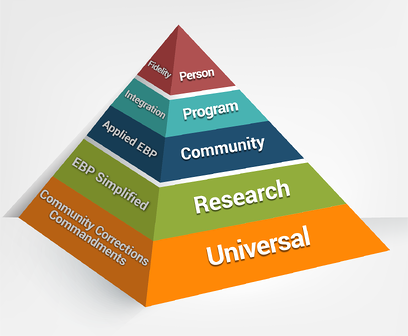- Home
- Software
- Support and Services
- Programs We Serve
- EBP
- Testimonials
- Blog
- About Us
- Resources
It is vital that community corrections’ purpose be agreed upon, clearly articulated and universally communicated. We believe the purpose is twofold: 1. Containment of current risk via behavioral monitoring (i.e., “short term public safety”) while 2. Reducing future risk via effective treatment (i.e., “long term public safety”). When leaders or groups of individuals do not believe in both goals and therefore attempt to sabotage one of them, community corrections becomes impotent and an afterthought.

While our collective experience and problem solving abilities remain vital, community corrections must embrace the new knowledge available to them, value it over personal experience, and hold itself accountable to adherence to the evidence based principles (EBP) that have been replicated hundreds of times. Implementing EBP is not easy and will require its existing leadership to manage change and steer the industry and its newcomers toward research based principles, not seat of the pants principles and practices.
Community: A group of people sharing a common interest
Community Corrections begins with “community” and must be local. Each community has different needs, different resources, and different stakeholders. Within the confines of our collective mission and established principles, local communities must be actively involved in the decision making about their community corrections programs. However, Local communities should be empowered to determine what it looks like in their locale, given their common interests. Communities typically demand and enjoy this empowerment, but they often drop the ball on the active involvement part. If communities want to remain empowered to make decisions about their community corrections programs, they must step up, embrace offender reentry, not just in theory but in day to day employment, recreation, and local activities.
Community corrections programs must answer to their local communities but those same stakeholders must provide the necessary resources and trust to allow and support the providers to accomplish the task. Program leadership must be able to demonstrate unusual competence and integrity and the ability to motivate people and manage change. Of all of the studied behavioral influences, none stands out as more powerful than environment. Indeed, it is an uphill battle to create change in an environment that reinforces the status quo. Change still requires structure, EBP implementation and therapeutic relationships. However, the absence of a healthy change oriented culture virtually makes offender change impossible. When in doubt, fight for a healthy culture.
Everything that happens in community corrections comes down to interactions between people. The front line staff has to be trained and provided with respectful oversight. Employee character and integrity is first and foremost but does not by itself create change. Similarly, employee training is absolutely vital, but coaching and mentoring generally provides more value. Behavioral change requires specific behavioral instruction, practice and feedback. The repetitive cycle of performance followed by feedback is the key to excellence. Want to know if you have a quality employee worth keeping? Give them feedback. Their reaction will tell you everything you need to know about their willingness to learn and their ability to pursue excellence.
CorrectTech offers integrated software and support services for residential, treatment, reentry, juvenile and probation programs. Our community corrections software was designed by community corrections professionals to guide organizations toward a powerful EBP implementation, relieve them of strenuous paperwork and manual processes, and enable them to focus on what matters - people! To request more information or schedule a demonstration of our software, click here.
CorrectTech, Inc.
info@correcttech.com
Copyright 2018 CorrectTech, Inc. All Rights Reserved.